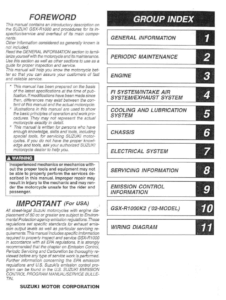Complete PDF version of the Service Manual for the Suzuki GSX-R 1000 K1-K2. A MUST for every GSX-R owner.
Download: Immediately after payment!
OEM Original factory workshop manual.
Models covered by this manual: 2001 and 2002
Number of pages: 443 pages
Table of contents:

This PDF repair manual can be downloaded right after the payment process in complete, on the device of your choice.
We do not offer printed manuals, for the following reasons:
- it is more eco-friendly to use a digital version
- your manual never gets dirty or greasy
- you can always choose to print the specific page(s) you need to work on your bike
- you receive your manual immediately after payment
- it is searchable

Suzuki GSX-R 1000
The Suzuki GSX-R1000 is a sport bike in Suzuki‘s GSX-R motorcycle series. It was debuted in 2001 to replace the GSX-R1100 and is powered by a 988 cc (60.3 cu in) inline four-cylinder, four-stroke engine that is liquid-cooled.
2001 (K1, K2)
Suzuki debuted a new GSX-R model in 2001, replacing the GSX-R1100, the largest and most powerful model in the GSX-R series, with the all-new GSX-R1000. The engine’s cylinder displacement was around 1,000 cc (61 cu in), which was approximately 100 cc less than its predecessor. Although it shared many characteristics with its smaller sibling, the GSX-R1000 was not simply an expanded version of the GSX-R750. The mainframe in both variants is the identical, however the material utilized on the big brother is.5 mm (0.020 in) thicker. Suzuki stated that the frame’s torsional stiffness has risen by 10% over the GSX-R750.
The engine in the GSX-R1000 was a revised GSX-R750 engine. The R1000 had a 1 mm (0.04 in) larger bore and a 13 mm (0.51 in) longer stroke, as well as freshly designed pistons with a lower crown and a gear-driven counter balancer. The engine weighed 130 lb (59 kg), making it somewhat heavier than the 750 engine but 31 lb (14 kg) less than the GSX1300R engine. The engine produces a maximum of 160 bhp (119 kW) at 9,500 rpm when measured on the crank and 143 horsepower (107 kW) when tested on the rear wheel, with minor variances between various instances of the same model.
The redline has been adjusted to 12,000 rpm. The engine’s maximum torque is 80 ftlbf (108 Nm) at 8,000 rpm. The GSX-R1000 has a peak speed of 173 mph (278 km/h), a 1/4 mile pace of 10.1 seconds at 141.7 mph (228.0 km/h), and a 0 to 100 km/h (62 mph) time of 3 seconds when combined with a total (dry) weight of 374 lb (170 kg).
The use of titanium for the exhaust downpipe (K1 model link pipe is black, K2 model link pipe is polished titanium) and the inside of the silencer allowed the 1000s exhaust system to be 4 lb (1.8 kg) lighter than the 750. Titanium was also utilized to coat the stanchions of the front fork (titanium-nitride). Inside the exhaust pipe, an exhaust tuning valve had been installed. The system used a servo to dynamically regulate the exhaust backpressure based on engine speed, throttle position, and gear selection for improved torque, reduced emissions, and lower noise—the (stock) exhaust noise of the GSX-R1000 is noticeably lower than that of the GSX-R600.
The 1998 Yamaha YZF-R1 was ultimately surpassed by the 2001 edition of the GSX-R1000, which was lighter and more powerful.
The 2001 model was carried over to 2002 with very minor alterations. Modifications to the fuel pump, clutch, front axle, torque link, mirrors, and luggage hooks were made in 2002. The manual fast-idle implementation was replaced by a computer-controlled implementation (the “STV servo”). New colors, as well as new GSXR stickers.
Source: Wikipedia

